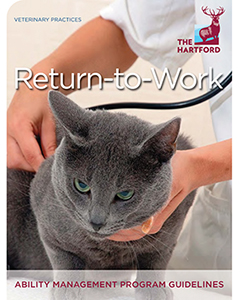Even when we try our hardest, workplace injuries can still happen. On-the-job accidents can be extremely expensive, especially for serious injuries. And with frequent or large claims, practices lose operating expenses to pay higher workers’ compensation insurance premiums. So how can your practice reduce insurance expenses and use those operating dollars on something else? One crucial element of reducing workers’ compensation costs is getting employees back to work as soon as possible after an injury.
Return-to-Work Program
How does returning employees to work affect the insurance costs? The answer is simple. Getting employees back to work faster helps reduce the overall claim cost and ultimately helps improve the practice’s experience MOD (see page two sidebar). The most significant portion of workers’ compensation costs is indemnity—the payment for lost wages. For most employers this equates to approximately 50% to 60% of workers’ compensation loss costs. Employers instituting effective return-to-work programs have reported considerable savings in workers’ compensation costs. In addition to lost wages, according to the National Institute on Disability and Rehabilitation Research, employees are less likely to seek legal counsel if the employer facilitates early return-to-work through light-duty positions.
A return-to-work program can be an excellent tool for controlling workers’ compensation costs, and it can also help improve productivity and employee morale. A return-to-work program enables an employee who sustains a work-related injury or illness to return to his or her original job duties as soon as possible. Designed to minimize disruptions and expenses, a return-to-work program provides temporary, transitional, or modified work duties to the employee. Early assistance allows the injured worker to maintain a positive connection to the workplace and can alleviate potential employee frustration and concern.
Top Seven Benefits:
- Reduces the likelihood of fraudulent claims
- Practice receives production for wages being paid
- Saves costs of training and replacing employees
- May speed up healing process
- Promotes good moral throughout the practice
- Keeps the employee mentally and physically acclimated to the work schedule
- Reduces negative financial impact of the injury or illness
According to the Bureau of Labor, cases involving days away from work accounted for 933,200 lost workdays in 2010.
Basic Program Elements
Return-to-work programs should operate hand-in-hand with your practice’s current risk management tools as one component of your overall risk management program. The basic elements of a return-to-work program include:
Develop Job Descriptions: Detailed functional job descriptions should include information about specific physical demands. Medical providers make informed decisions about an individual’s specific capacity and limitations relative to the written job description.
Provide Alternate Duty: When an injured or ill employee has limitations, it may be necessary to place the employee in a different job to continue working. Create a job bank that lists different job types (with detailed job descriptions) that you can use when an employee needs alternative duties. When you are determining transitional jobs, consider the types of restrictions that are typically associated with various injuries.
If injured employees are not offered alternate duty, they are allowed to stay at home. When at home, the employee can perform a variety of different activities such as: sit for extended periods of time (watching TV), answer the phone, work at a desk or counter, pay bills, carry out trash, lift a gallon of milk (8lbs), and execute a range of different everyday tasks. If all of these activities can be done at home, why not have the injured employee perform similar activities at work? Avoid paying an employee to stay home when tasks at the practice can be accomplished with accommodating work restrictions. The longer an employee is out of work, the harder it becomes to get the employee back to work. Although the employee may not be able to produce at 100%, some productivity is better than none. Keeping the employee active can help promote physical and mental healing as well as create good morale throughout the workplace.
Work Hardening or Conditioning: Ideally, employees that return after an absence return to their previous position—but this is not always the case. Getting employees to return-to-work is more apt to be successful if they are allowed to return gradually, slowly building up strength and endurance for job demands.
Studies show that employees who stay out of work with a job-related injury for more than twelve weeks have less than a 50% chance of ever returning.
What is an Experience Modification (MOD) Factor?
An experience modification factor is a vehicle that operates as a financial incentive to promote loss prevention. It benchmarks workers’ compensation claims experience by industry and size. The National Council on Compensation Insurance (NCCI) (or an independent agency, depending on your state) calculates experience MODs using payroll, number of hours worked, and accidents. A MOD calculates your total claim costs during the last three full policy years. Depending on your state, there is a minimum eligibility requirement for an experience rating. Typically, a workers’ compensation premium of more than $5,000 will trigger an experience modification. The industry average is 1.0, and the goal is to be at or below this average. The MOD factor is then applied to your policy to modify your workers’ compensation premium. Here's an example:
| |
Premium |
MOD Factor |
Modified Premium |
| A practice with a favorable MOD rating (less than 1.0) will receive a premium credit for maintaining a safer workplace. |
$5,000 |
x 0.75 |
= $3,750 |
| Industry Average |
$5,000 |
x 1.00 |
= $5,000 |
| Practices with a higher MOD rate (more than 1.0) will be assessed a charge for losses and pay a higher insurance premium. |
$5,000 |
x 1.50 |
= $7,500 |
Action Step: Implement a Program at Your Practice
Implement an effective return-to-work program at your practice and tailor the program for your practice. Successful programs can lead to better results in workers’ compensation and short- and long-term disability claims and can enhance human resource benefit programs. Download this booklet of veterinary specific guidelines developed by our Risk Consultants and The Hartford.

Download a Return-to-Work Program Model:
 |
 |
| Microsoft Word |
Adobe PDF |